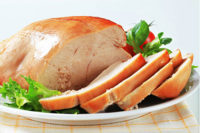
By Lynn Knipe, Ohio State University
Injection and marination are intended to add solutions to meat to affect product color, texture, flavor, plus protein and water-binding abilities. Even and consistent distribution of these solutions throughout whole-muscle product should be the ultimate goal, and injection can maximize the uniformity of the solution distribution. Good slicing yields and uniform cured color are two results of uniform distribution of injected solutions. Color defects such as tiger-striping, poor slicing yields, plus inconsistent texture and cooking yields are all results of uneven distribution of injected solutions. Tumble marination can accomplish the same objectives as injection using less equipment, if done properly, and is often used with solutions that contain spice or seasoning particles too large for injection needles.
Meeting injection targets for solution uptake into meat pieces is a result of balancing pump pressure, injection time and needle design. Injection time involves speed of the conveyor or walking beam, number of passes through injector (or number of injection heads), injecting on both the up stroke and the down stroke (versus only injecting on the down stroke), etc.
Pump pressure
Balancing injection pressure can be a challenge. Increasing pump pressure has been used in the past as a means to increase injection level. However, injecting at too high of a pressure may cause quality problems for products. For example, injecting pork bellies at too high of a pressure will result in solution accumulation in the fat streaks and seams, causing pickle pockets. On the other hand, injecting at too low of a pressure may result in under-cured spots, due to uneven distribution of the curing solution.
Injection time
Higher injection levels can be accomplished with lower pump pressures by increasing injection time by methods such as: increasing needle numbers (i.e., closer needle spacing), multiple passes of product through the injector and reducing the conveyor/walking beam speed. Some injectors are designed with multiple heads to simulate multiple passes through an injector. Multiple passes through an injector simulates the effect of closer needle spacing. Other injectors are designed to inject both in the down stroke and the up stroke, to increase solution retention. Reducing the speed that meat moves under the injector head will increase the number of times that the meat is injected, allowing for lower pump pressures.
Needle design
Most injector needles for bacon have holes at the end of the needles, however, needles designed for other whole-muscle products have holes along the sides of the needles. Side-port needles direct the solution in multiple directions away from the needle, which improves the solution distribution and retention in larger whole-muscle products. One solution of products requiring a lower level of solution uptake would be to use smaller diameter needles with smaller holes. Larger diameter needles would be used for higher injection level products.
Tumble marination
Incorporating marinades or curing solutions into meat products can be done without injection by a process that resembles the traditional immersion process. This process is controlled by holding time and mechanical action, such as tumbling and/or massaging, and the extent of both is determined by the size of the piece of meat that is being treated. If available holding time is limited, mechanical action needs to be more vigorous to maximize brine distribution, and vice versa. Tumble marination can easily be less consistent in solution distribution, unless sufficient time and mechanical action are applied. Absorption of excess solution will be enhanced by macerating the surface of the meat pieces.
Product temperatures
To maximize protein extraction and minimize microbial growth during tumbling and massaging, maximum product temperatures should be 40 F during injection, although more optimal product temperatures would be 35 F to maximize protein extraction. However, warmer product temperatures have been shown to result in better uptake and retention of solutions and, in the case of pork bellies, higher cooking yields. To remedy this problem, one equipment manufacturer has developed a massaging unit that warms the product after injection, followed by a chilling cycle for proper protein extraction and to minimize microbial growth.
Needle-free injection
A new concept is injecting solutions into meat without needles, which is referred to as “injetting” by one manufacturer. A major advantage to this approach would be the elimination of the potential contamination hazard due to needles protruding into the center of pieces of meat. Also, higher solution injection levels are claimed with the needle-free process, and meat can be injected at multiple angles, rather than the single dimensional process of traditional injectors.
Conclusions
Optimizing solution uptake into meat pieces is a result of balancing pump pressure, injection time and needle design. There are some general engineering and meat science rules to follow to meet injection targets for solution uptake, however, the variety of raw material species, injectors, tumblers, etc., cause this to be a rather empirical process.
Lynn Knipe is the Extension Processed Meats Specialist and Associate Professor in Food Science and Technology and Animal Sciences at Ohio State University. He is also a member of The National Provisioner Editorial Board. For more information, contact him at knipe.1@osu.edu or (614) 292-4877.



Report Abusive Comment